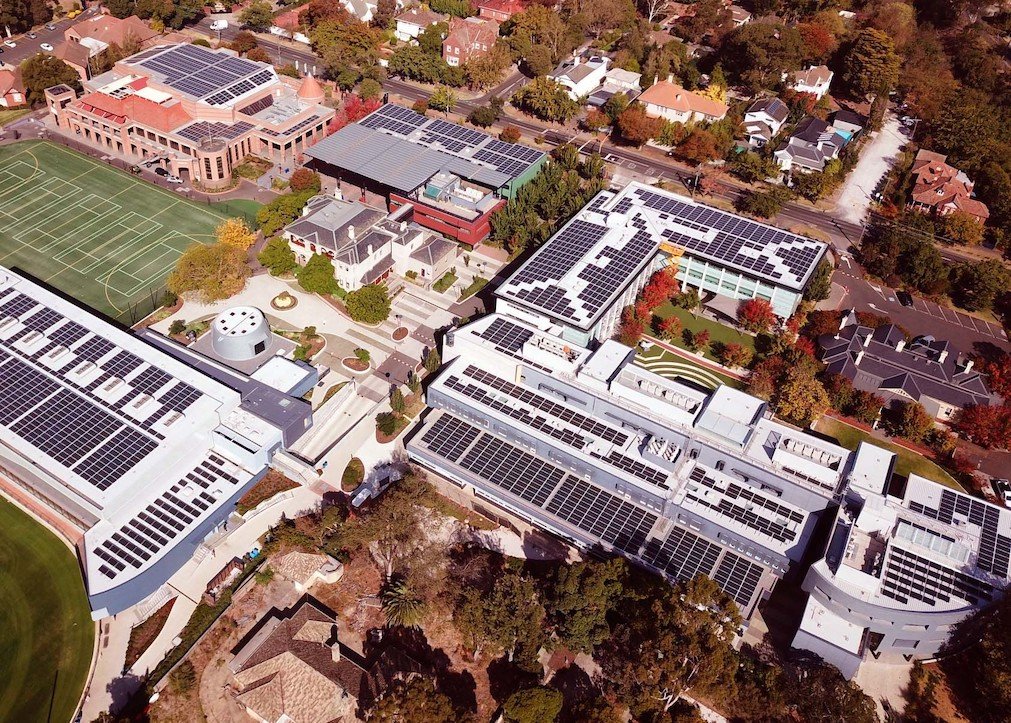Camberwell Grammar School
Case Study
Camberwell Grammar School (CGS), an independent school for boys, has one of the largest solar installations on a school in the southern hemisphere and is aiming to be carbon neutral by 2030 and climate positive beyond that.
Electrify Boroondara spoke with Will Hone, Sustainability Co-Ordinator at CGS about their electrification journey.

Why did CGS embrace electrification?
Will highlights the central role played by students in driving several initiatives and says as CGS is developing programs that allow students to become change agents, their views are a powerful influencing factor.
While the initial idea for solar panels came from a group of students interested in sustainability in 2016, there was also significant support from the School leadership and Board.
The journey so far
CGS now has 2,600 solar panels that generate 48% of their total energy usage. The gap is filled by renewable energy sourced from the south-east coast of Australia. The payback for their solar panels is between seven and nine years. “While it was a significant investment, it will pay for itself,” says Will.
At the end of 2021, the school committed to achieving carbon neutrality by 2030. To assist with this huge project, they engaged CERES to consult on their progress, and hired a Sustainability Project Coordinator in 2023 to guide the process and help with quarterly reporting.
“Becoming climate positive involves achieving net zero by cutting our emissions as far as possible by reducing energy, waste and transport – and beyond that it also means focusing on water usage and biodiversity indicators,” says Will.
Other initiatives include replacing almost all lights with LED bulbs, installing electric hot water systems as gas units reach their end of life and coordinating the Building Management System to control lights and air conditioners.
The school is actively involving students, teachers, and the school community in their sustainability journey.
“The students are particularly keen to see they have a future. A big part of this is saying to them, ‘You are in a place where you can make change happen. Your voice is heard. Your voice counts,’” explains Will.
“We're working on weaving solar into the curriculum and have created student groups so there’s opportunities for kids to get their teeth into the school’s operations and contribute to the climate positive program. They work on biodiversity through the gardens and beehives, on waste through recycling, FOGO communications and other collections such as clothes, e-waste, mobile phones and pens. There's lots of different ways kids can engage in communal behavioural change, which I think is really important on many different levels.”

What is on your wish list?
“Electrifying transport and large-scale operations like the pool heater (currently heated with gas) are foremost on my wish list. We've got an EV charger for people who drive electric cars, but we have huge amounts of transport to and from sports grounds. I'd love for there to be electric buses.
Schools are dynamic places so moving forward I’d like to see all new buildings rated at least five stars. We need care and attention taken not just to double glazing, but to wall, floor and roof insulation and ensuring they’re designed with passive heating and cooling, water storage and end of life all taken into account.”
What advice would you give to other schools?
“Be brave.” In talking to teachers from other schools, Will says he often hears their administrations won’t release data on waste or energy. “That's where schools need to be brave and open themselves up – we are all on this journey together.”
“Every school can join Resource Smart Schools, an amazing program run by Sustainability Victoria, and start the first step to going net zero by measuring your energy, waste and water use through your bills.
We’ve used it to store our bills in one place. From 2016 to now we have a comparison of how much we've been spending and how much we've saved. And if you don't want to use Resource Smart Schools, you can establish your own spreadsheet.
People need to be given work capacity to do this. We need to empower passionate teachers by giving them time and professional development to enable them to start making this shift.
We can do this. We've got the solutions. We have the technology. We just need to find the political and social will to make this happen. And we can do that in schools.
It is a journey. It's a lot of work, but it's extremely rewarding. When I make a presentation to the staff, people are genuinely excited to work somewhere where we're doing something for the future.”


